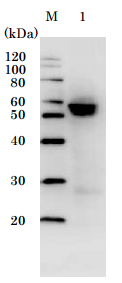Description
Influenza virus is an RNA virus, which causes influenza, and belongs to the family Orthomyxoviridae. Influenza virus is classified into three different genera, influenza virus A, B, and C. They all have similar structures and compositions. The virions are 80-100nm in diameter and usually roughly spherical. The outer surface of the virion is made of a viral envelope containing two major glycoproteins, hemagglutinin (HA) and neuraminidase (NA). Influenza virus A is further classified into subtypes based on the surface glycoproteins, HA and NA. Currently, there are 16 HA and 9 NA subtypes. The central core of the virion contains the viral RNA genome, which is packaged in the form of ribonucleoprotein complexes.
Influenza virus nucleoprotein (NP) is a major component of the ribonucleoprotein complex and is abundantly expressed during the course of infection. It is a structural protein, which encapsidates the negative strand viral RNA and is essential for RNA transcription, replication and packaging. NP binds the PB1 and PB2 subunits of the viral RNA polymerase and the matrix protein M1, in addition to its binding to ssRNA. NP is also known to interact with variety of other macromolecules of both viral and cellular origins, and these interactions have been shown to be essential for the viral lifecycle.
Applications
- Western blotting (~1,000 fold dilution)
- Immunocytochemistry (~200 fold dilution)
- Immunohistochemistry (~200 fold dilution)
- ELISA (assay dependent)
Specification
Immunogen: Human Influenza A Virus (H2N2) Okada strain
Reactivity: Reacts with NP of all influenza A viruses tested so far, including seasonal H2N2, H3N2, and avian H5N1, H5N2 and H1N1 (seasonal, pandemic, and swine). No cross reactivity with influenza B viruses.
Isotype: mouse IgG2A
Product: Produced in serum-free medium and purified by proprietary chromatography procedure under mild conditions. Horseradish peroxidase conjugated.
Form: 1 mg/ml in PBS, 50% glycerol, filter sterilized. Azide- and carrier-free.
Storage: Shipped at 4°C or -20°C. Upon arrival, spin down and store at -20°C.
Data Link: Swiss-Prot Influenza NP
References: This antibody was described and used in the following references.
- Mizuike R. et al. Development of Two Types of Rapid Diagnostic Test Kits To Detect the Hemagglutinin or Nucleoprotein of the Swine-Origin Pandemic Influenza A Virus H1N1. Clin Vaccine Immunol 18: 494–499 (2011) PubMed ID: 21228147 (IF/ICC)
- Ueda M. et al. Maturation efficiency of viral glycoproteins in the ER impacts the production of influenza A virus. Virus Research 136: 91–97 (2008) PubMed ID:18550190 (WB)
- Okuno Y et al . A common neutralizing epitope conserved between the hemagglutinins of influenza A virus H1 and H2 strains. J Virol 67: 2552–2558 (1993) PubMed ID:7682624 (IP)

Fig.1. Western blotting of MDCK cells infected with H1N1 (A/PuertoRico/8/34), H5N1 (A/duck/HK/342/78), or H5N2 (A/crow/Kyoto/53/04) using C43 antibody.
Samples were collected at 3, 9, 24, and 48 hours post-infection. C43 detected NP after 3 hours post-infection and detected three different types of influenza viruses.

Fig.2 Western blotting of MDCK cells infected with H1N1 (A/PuertoRico/8/34) using HRP-conjugated C43 antibody.
Proteins in the infected cell lysate was separated by 15% SDS-PAGE and blotted to PVDF membrane. The membrane was reacted with C43 monoclonal antibody, conjugated with HRP at 1/1,000 dilution, and visualized by chemiluminescence.


Reviews
There are no reviews yet.